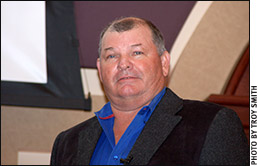Heavy Considerations
Consider welfare, other ramifications of feeding cattle to larger end points.
How has cattle feeding changed in recent years? As a technical services manager for Merck Animal Health and a bona fide industry watcher, Wade Nichols has seen feeding periods extended to 150 days — even to 180 days. Accordingly, finished cattle weights now reach levels seldom seen before. Hot carcass weights have increased, now averaging in excess of 830 pounds (lb.). Dressing percentages are up, too, as is the percentage of cattle grading Choice or better for quality.
“What’s the incentive for increased days on feed? It’s because it improves margin,” Nichols told an audience gathered for the 2016 International Symposium on Beef Cattle Welfare hosted June 8-10 in Manhattan, Kan. “We feed cattle longer to reach heavy weights because we can.”

“We feed cattle longer to reach heavy weights because we can,” said Wade Nichols, technical services manager for Merck Animal Health. The trend has been accompanied by consequences related to animal welfare.
Nichols explained that cattle feeders are rewarded for taking cattle to very heavy weights, when they sell on a carcass basis, with premiums awarded for carcass merit. Indeed, 85%-90% of fed cattle are sold that way, rather than live. Nichols said little more than 20% of finished animals are sold live for a negotiated cash price.
According to Nichols, the trend has been accompanied by consequences related to animal welfare. Cattle fed to today’s heavier weights must be managed differently than shorter-fed, lighter-weight cattle. Nichols said management of nutrition is particularly important, calling consistency of diet critical for long-fed cattle. He also talked about associated maladies that must be managed.
“We need to consider the increased susceptibility [of long-fed, heavyweight cattle] to heat stress, which we can mitigate by manipulating rations and providing shade, water sprinklers and ample [drinking] water. Bedding can help, too. Using straw actually keeps a pen’s surface cooler by reflecting heat,” explained Nichols. “We also need to handle cattle appropriately to avoid heat stress.”
Nichols advised, as a routine practice, the “staging” of cattle for shipment. To avoid excessive handling and overexertion of cattle, they should be moved to a pen near the load-out area some time near the end of the finishing period but well ahead of shipping day. Nichols’ other handling tips included keeping cattle off concrete whenever possible and avoiding situations that leave cattle standing too long on a loaded trailer. He noted the importance of adequate, well-maintained load-out facilities and competent, well-trained personnel.
Watch for additional coverage of the 2016 ISBCW on www.angus.media and in the Angus Journal and Angus Beef Bulletin. Comprehensive meeting coverage will be archived at www.api-virtuallibrary.com/meetings_other_news.html.

Editor’s Note: Troy Smith is a cattleman and freelance writer from Sargent, Neb.





